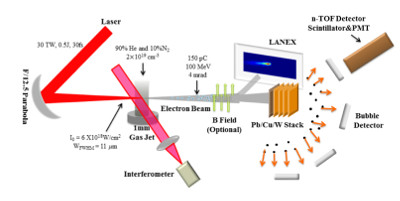
Posted: 4/9/16
Author: X. Jiao
Topic: Neutron
Neutron source from electron acceleration on UT3
We had our preliminary experiment on UT3 laser system at the University of Texas at Austin. UT3 is a 30-TW, 800 nm laser, which operates at repetition rate of 10 Hz. To generate LWFAs, 30fs, ~1J, linearly polarized laser pulses was focused to spot size of 11 μm (FWHM) with peak intensity of 6 ×1018 W/cm2. The experiment run at 30 seconds per shot due to the capability of the turbo pump. A transverse interferometer measured averaged plasma density profile. A magnetic electron spectrometer was placed after the gas jet to analyze energy spectra of magnetically dispersed electrons on each shot. The energy and charge of the electron beam that is suitable for maximizing neutron production will be optimized by controlling plasma density, which in turn was determined by the gas type and density. The basic physics process behind this experiment is utilizing laser-plasma interaction to create relativistic electrons, which will then incident on metal converter and radiate -ray through Bremsstrahlung radiation. High energy -ray (>10 MeV) will activate certain photonuclear reaction and eventually radiate neutrons.
The main beam came from the right side of the chamber and focused on the gas target through a F/12.5 Off Axis Parabola (OAP) with the help of a turning mirror. The gas target was composed of 90% of He and 10% of N2 to provide more electron injection in LWFA. The probe beam that was separate from the main beam before enter the chamber was send into the chamber from another flange. The copper converter was place 5 cm away from the gas jet. A magnetic electron spectrometer consisting of a LANEX screen, a commercial phosphor plate, placed downstream of the target. The LANEX was imaged by a 12-bit CCD camera to acquired instant intensity map of electrons. The electron spectrometer was design and build that are capable of measuring electron energies between 10~50 MeV. Five bubble detectors were deployed around the chamber, which were used to measure the neutron flux. Bubble detectors are composed of little tiny droplets of superheated liquid. Neutron would deposit energy on the bubble detector through elastic collisions. Then the droplets would vaporize and form visible gas bubbles trapped in gel, which is visible with bare eyes. The bubble detector has zero sensitivity on gamma ray and very suitable for this applications. A neutron Time-Of-Flight (n-TOF) was place 2.2m away. It was used to measure the neutron energy distribution. Figure 3 illustrated how n-TOF works. The first part of n-TOF is plastic scintillator, will emit light of certain wavelength after hit by neutrons. The light would then cause photoelectric effect on photon multiplier tube (PMT) and generate electrons, which is then amplified by the tube and generate signal and eventually detected by a fast oscilloscope.
The electron beam generated through LWFA in our experiment had very low divergence, which made an online electron measurement impossible. Before we put in the converter, we took a bunch of shot to analyze the electron beam. The electron energy has a wide distribution from 12 MeV to 50 MeV. The electron energy peak located around 40 MeV.
An isotropic neutron flux was observed. The absolute number of neutron generated in our lab is 2x106 per shot. To get neutron energy distribution, we took 200 shots and accumulate the signal, then used data fit to get the accumulated signal. The actual energy distribution was get by differentiating the polynomial fit. Detecting neutron energy spectrum with low flux is a universal challenge. Because there is no energy sensitive detector for neutrons. The only way one can measure neutron energy is using time of flight method, which require the detector to be set far away to get accurate results. This practice drastically reduces the signal received. In our case, the averaged neutron detected by the n-TOF is close to 1.6.